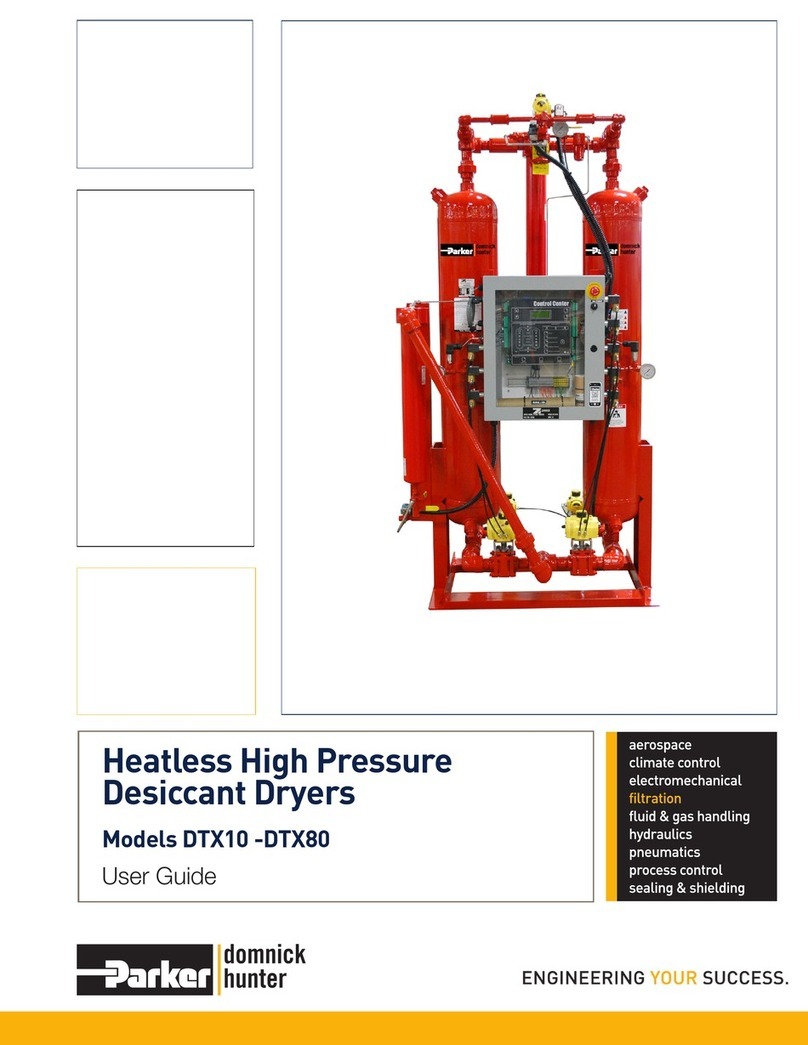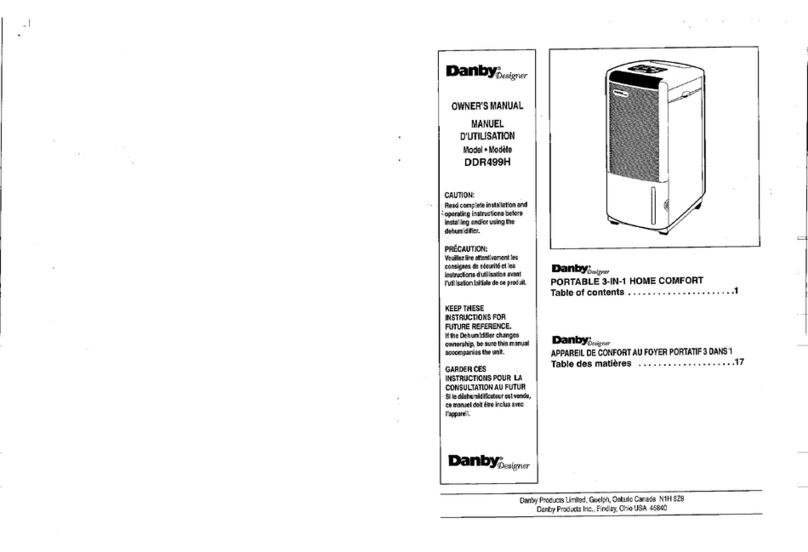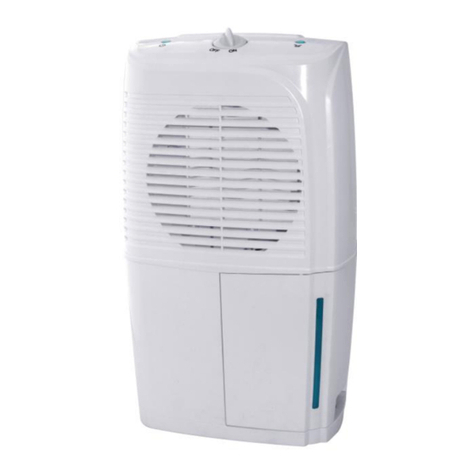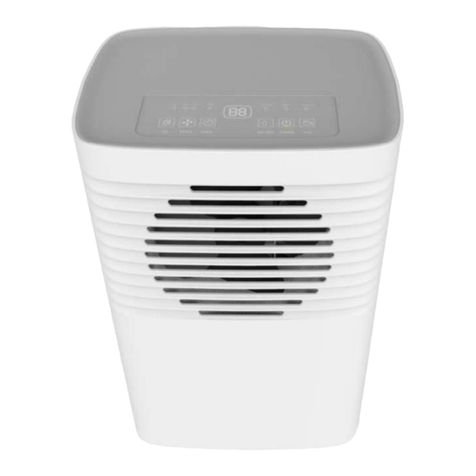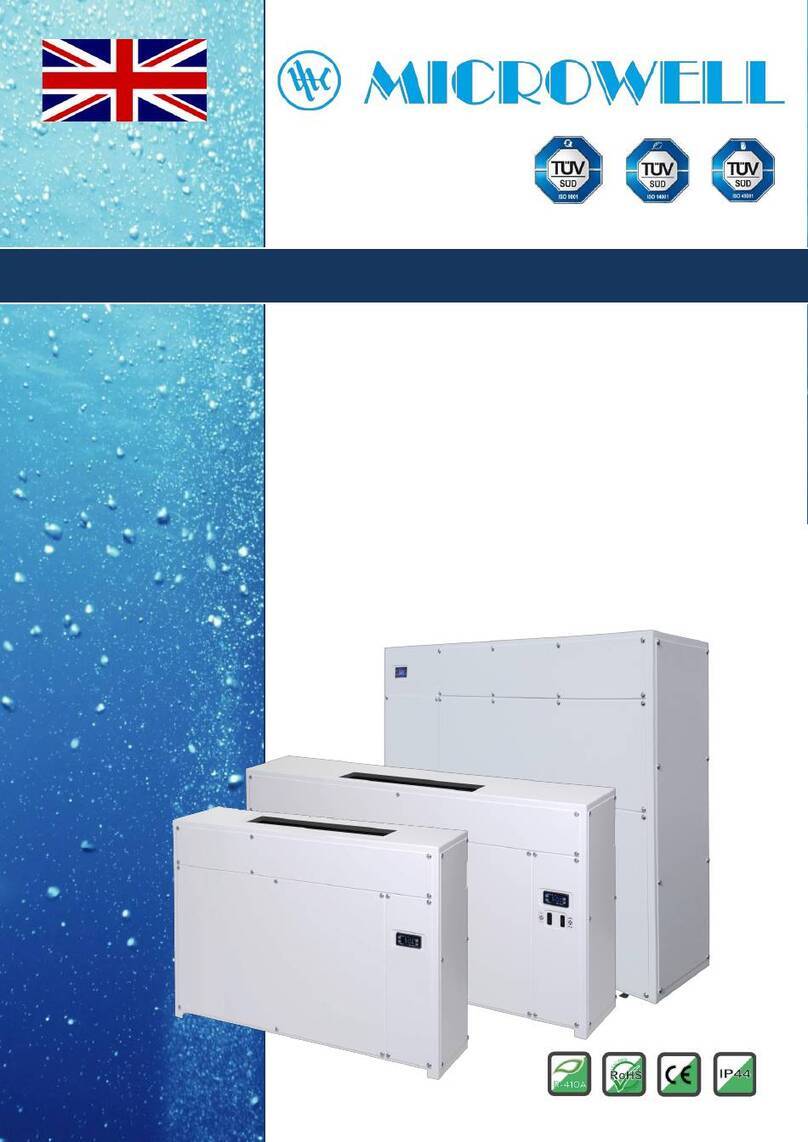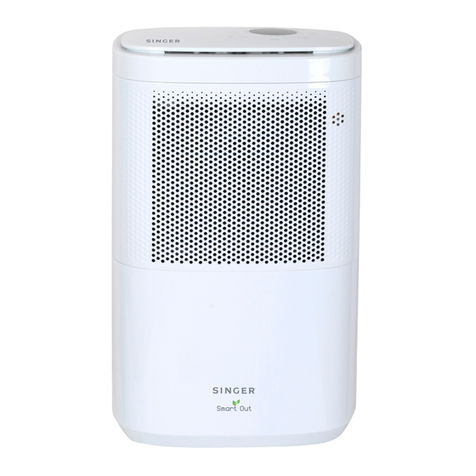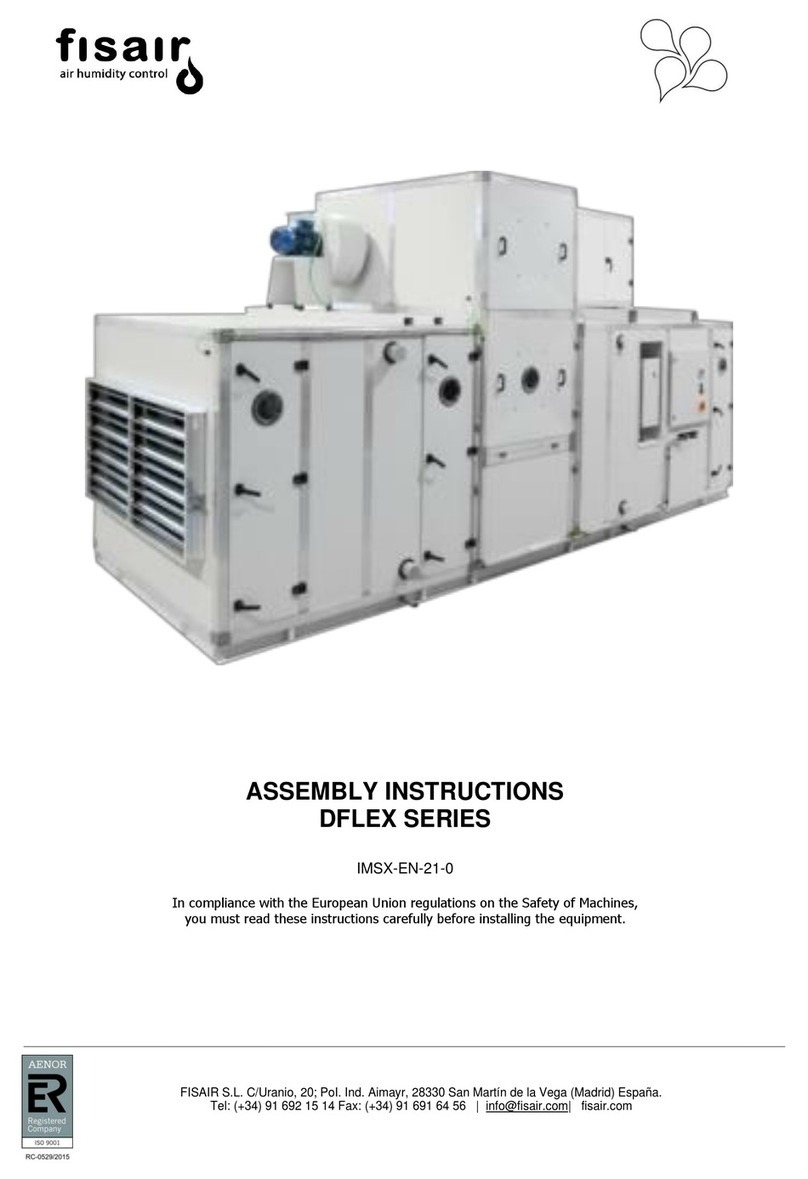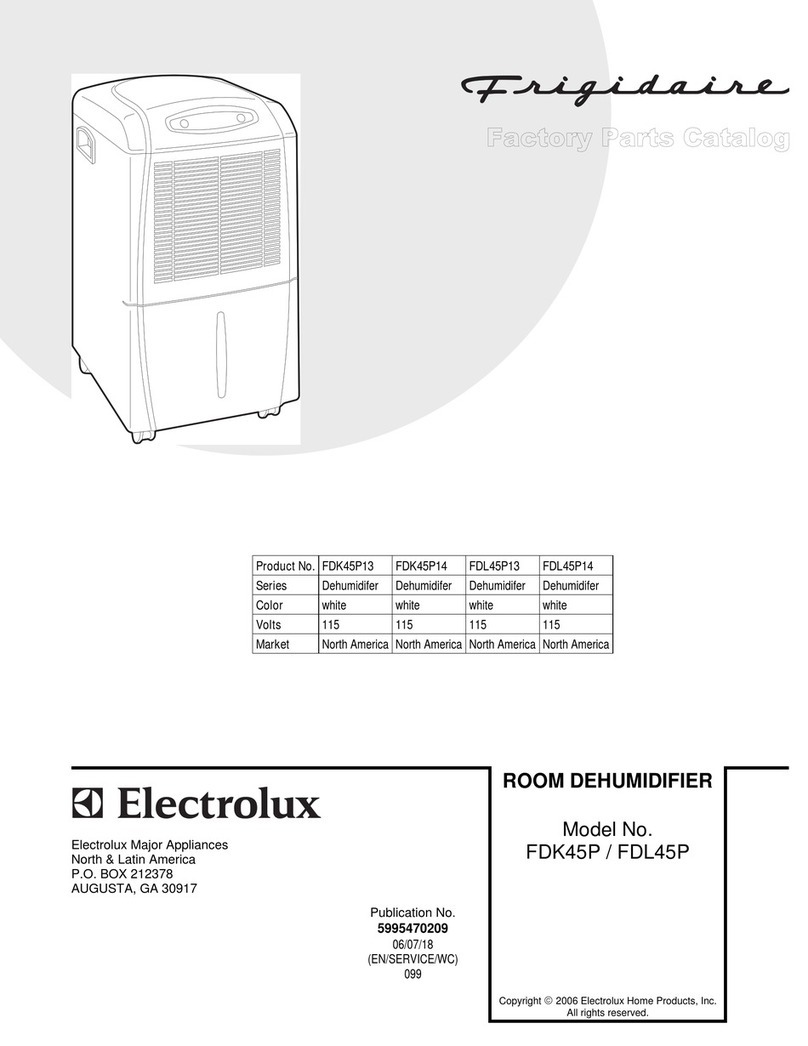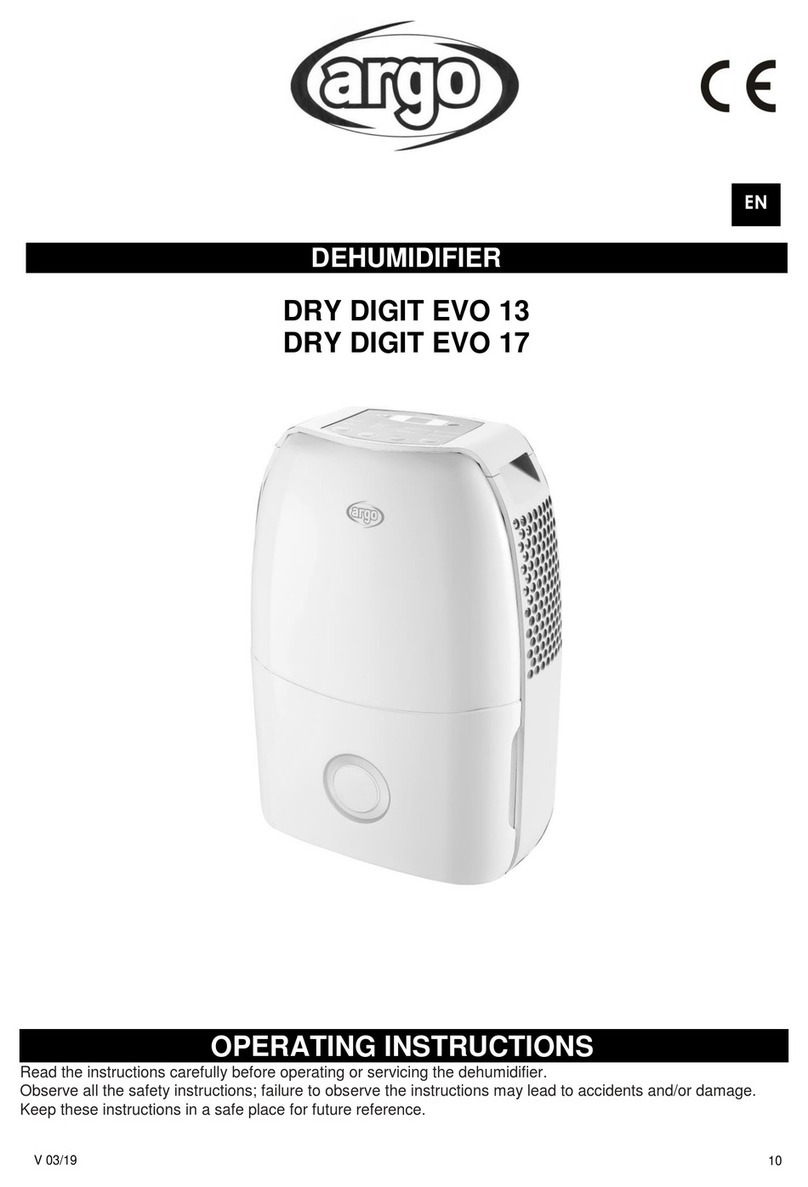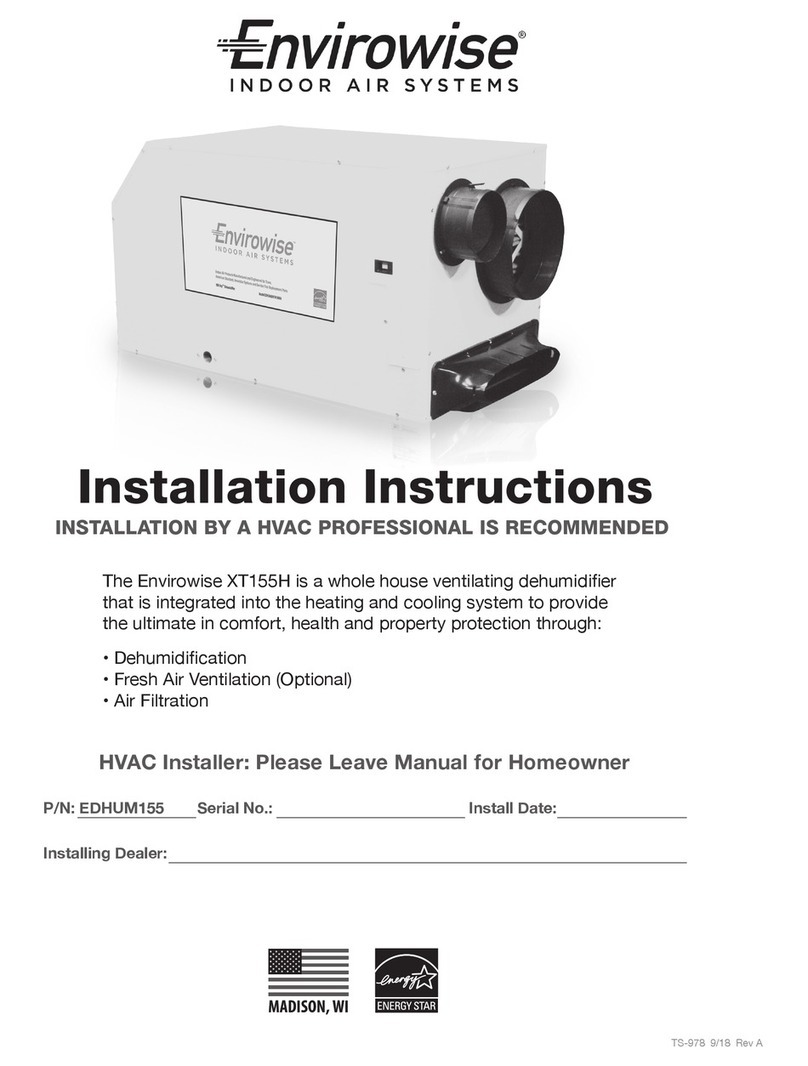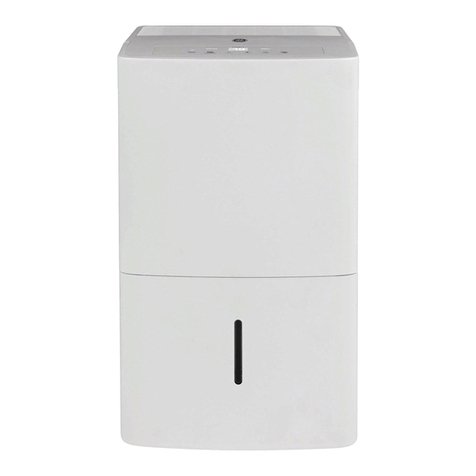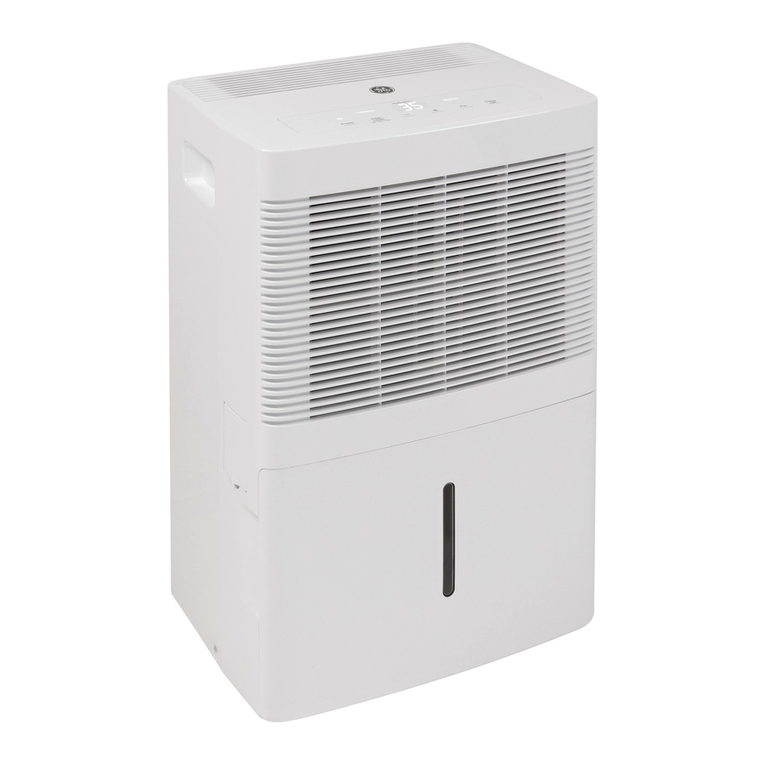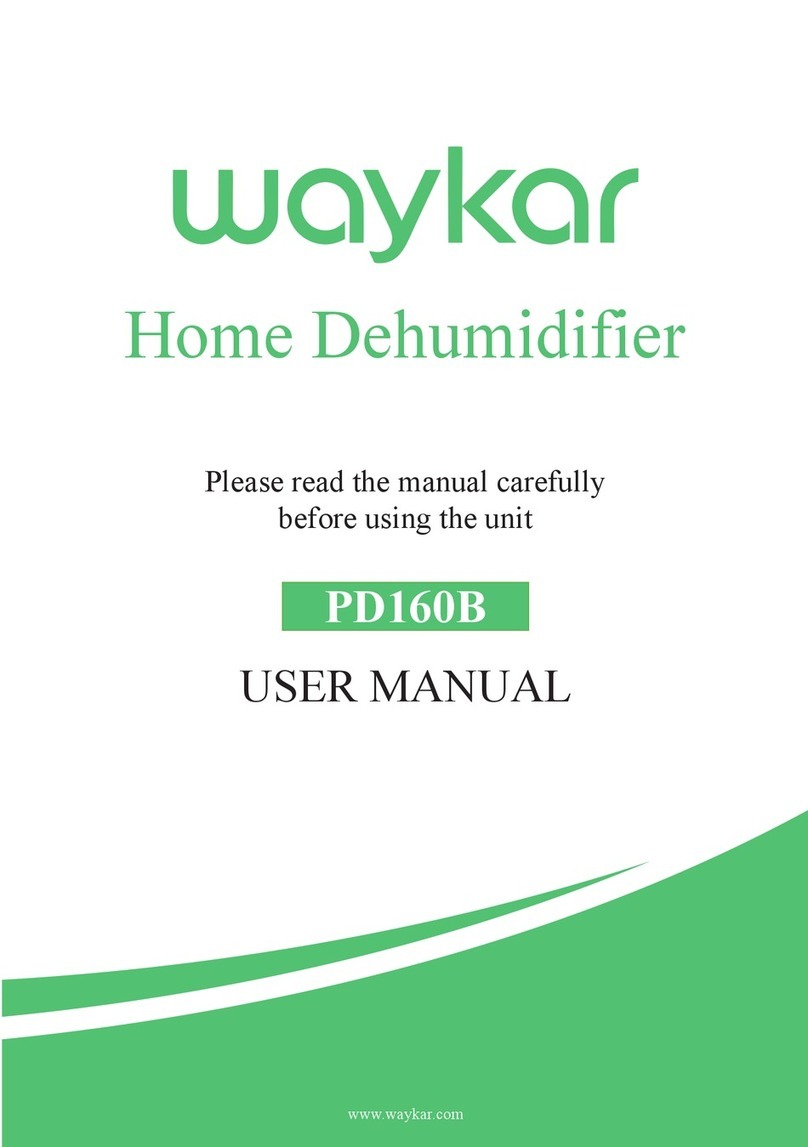SPX Hankison HPRplus Series User manual

REFRIGERATED
TYPE
COMPRESSED
AIR DRYERS
CONTENTS
GENERAL SAFETY INFORMATION.......................2
RECEIVING, MOVING, AND UNPACKING.............2
1.0 INSTALLATION .................................................3
2.0 OPERATION .....................................................5
3.0 MAINTENANCE................................................10
SIZING.....................................................................11
ELECTRICAL SCHEMATICS
Models 1000 and 1250.........................................12,13
Model 1500 ..........................................................14,15
Models 1750, 2000 and 2500...............................16,17
Model 3000 ..........................................................18,19
DIMENSIONS / WEIGHTS......................................20
ENGINEERING DATA .............................................21,22
TROUBLESHOOTING GUIDE................................23
PARTS LIST ............................................................24
WARRANTY ............................................................28
SERVICE DEPARTMENT: (724) 746-1100
INSTRUCTION MANUAL
HPRplus Series with ColdWave™ Technology
Models: HPRP 1000, 1250, 1500, 1750,
2000, 2500, 3000
5001321 Rev. B 8/08

2
RECEIVING, MOVING, AND UNPACKING
A. RECEIVING
This shipment has been thoroughly checked, packed and
inspected before leaving our plant. It was received in good
condition by the carrier and was so acknowledged.
Check for Visible Loss or Damage. If this shipment shows
evidence of loss or damage at time of delivery to you,
insist that a notation of this loss or damage be made on
the delivery receipt by the carrier’s agent.
B. UNPACKING
Check for Concealed Loss or Damage. When a shipment
has been delivered to you in apparent good order, but
concealed damage is found upon unpacking, notify the
carrier immediately and insist on his agent inspecting
the shipment. Concealed damage claims are not our
responsibility as our terms are F.O.B. point of shipment.
C. MOVING
In moving or transporting dryer, do not tip dryer onto its
side.
D. STORAGE/SHUT DOWN
Dryer should not be stored outside (either
packed or unpacked) or exposed to the weather. Damage to
electrical and control components may result.
IMPORTANT: WATER-COOLED UNITS - If unit is shut down
below freezing temperatures, the water-cooled condenser may
freeze and cause permanent damage. Condenser must be
drained when the unit is shut down.
IMPORTANT: Do not store dryer in temperatures above 130°F
(54°C).
GENERAL SAFETY INFORMATION
1. PRESSURIZED DEVICES:
This equipment is a pressure containing
device.
• Donotexceedmaximumoperating
pressure as shown on equipment
serial number tag.
• Makesureequipmentisdepressurizedbeforeworking
on or disassembling it for service.
2. ELECTRICAL:
This equipment requires electricity to
operate.
• Installequipmentincompliancewith
all applicable electrical codes.
• Standardequipmentissuppliedwithelectrical
enclosures not intended for installation in hazardous
environments.
• Disconnectpowersupplytoequipmentwhenperforming
any electrical service work.
3. BREATHING AIR:
• Airtreatedbythisequipmentmay
not be suitable for breathing without
furtherpurication.
Refer to applicable standards and
specicationsfortherequirements
for breathing quality air.

3
IMPORTANT: READ PRIOR TO STARTING THIS EQUIPMENT
1.0 INSTALLATION
1.1 Location
A. For typical placement in a compressed air system, see
drawing.
B. Air compressor intake – Locate air compressor so that
contaminants potentially harmful to the dryer (e.g.
ammonia) are not drawn into the air system.
C. Dryer should be installed in a moderately heated, well
ventilated area. Avoid locations immediately adjacent
to cold exterior windows or walls, or adjacent to high
temperature ovens or boilers.
D. Clearances:Freeairow
Front 37.3/8 inches (950 mm)
Back 37.3/8 inches (950 mm)
Left Side 37.3/8 inches (950 mm)
Right Side 6 inches (153 mm)
Top 25.5/8 inches (650 mm)
Service - To facilitate maintenance leave 37.3/8 inches
(950 mm) of clearance in front of dryer.
E. Standard units are designed to operate in ambients:
Air-cooled: 40 to 110°F (4 to 43°C).
Water-cooled: 40 to 130°F (4 to 54°C).
F. Dryer is designed to operate at all altitudes - no
adjustment for altitude is required.
G. Theinstallationofaexibleconnectionpriortothedryeris
recommended to prevent possible damage from vibration.
NOTE: Outdoor installation – Standard units are designed for
indoor installation. Contact manufacturer if installing outdoors.
Aftercooler
Separator
Dryer
Compressor
COOLING WATER
INLET
COOLING WATER
OUTLET
COOLING WATER
OUTLET
COOLING WATER
INLET
FILTER MONITOR
(OPTIONAL)
COOLING AIR FLOW
COOLING AIR FLOW
CONDENSATE DRAIN
(OPTIONAL)
CONDENSATE DRAIN
CONDENSATE DRAIN
LEFT SIDE VIEW
CONTROL PA NEL
FRONT SIDE VIEW
SEE DETAILS ‘A’ AND ‘B’
FOR WATER CONNECTION
PORT IDENTIFICATION
DETAIL ‘A’
Cooling Water Connection Ports for
Models 1000, 1250, 1500
DETAIL ‘B’
Cooling Water Connection Ports for
Models 1750, 2000, 2500, 3000

4
1.2 Mounting
Mount the dryer on a level solid surface. Holes are provided in
thedryerbasetopermanentlymountthedryertotheoor.
1.3 Piping Connections
A. Air Inlet - Connect compressed air line from air source to
air inlet.
Refer to Serial Number Tag for maximum
working pressure. Do not exceed dryer’s Maximum Working
Pressure.
NOTE: Install dryer in air system at highest pressure possible
(e.g. before pressure reducing valves).
NOTE: Install dryer at coolest compressed air temperature
possible. Maximum inlet compressed air temperature: 120°F
(49°C). If inlet air exceeds this temperature, precool the air with
an aftercooler.
B. Air Outlet - Connect air outlet to downstream air lines.
C. Bypass piping - If servicing the dryer without interrupting
the air supply is desired, piping should include inlet and
outlet valves and an air bypass valve.
D. Water-cooled models - cooling water inlet and outlet
1. Connect cooling water supply to cooling water inlet.
2. Connect cooling water return line to cooling water
outlet connection.
NOTE: Strainer and water regulating valve are supplied on
water-cooled models. Also, it is recommended to add water
inlet/outlet temperature and pressure gauges to the water
piping.
1.4 Electrical Connections
IMPORTANT: Use copper supply wires only.
A. Dryer is designed to operate on the
voltage, phase, and frequency listed on
the serial number tag.
B. Electrical entry is through a hole in the
top of the cabinet. Route wires through the bottom of the
electrical enclosure. Connect power source to the terminal
strip in the electrical enclosure as shown on the electrical
schematic included with the dryer.
NOTE: Refrigeration condensing unit is designed to run
continuously and should NOT be wired to cycle on/off with the
air compressor.
1.5 Electronic Demand Drain
A. An automatic electric demand drain (EDD)
discharges condensate removed by the
separator.
B. All dryer models are supplied with one
EDD. Models with the additional (optional)
oilremovallteraresuppliedwithasecond
EDD.
C. Thedrainsarepipedtottingsinthelegoftheunit.
Condensateshouldbepipedfromthisttingtoanopen
ventedoordrainorsump.
NOTE:Discharge is at system pressure. Drain line should be
anchored.
NOTE:Condensate may contain oil. Comply with applicable
laws concerning proper disposal.
D. Verify that isolation valves are open. If the drain fails to
discharge after the valve is energized, the electronic con-
trol circuit will repeatedly energize the valve in an attempt
to clear the discharge port. If, after 60 seconds, the drain
still fails to discharge, the control circuit then switches to
the alarm mode. In this mode the valve is de-energized
and the red alarm light is activated on the drain and the
dryer controller. The valve is then automatically energized
every 4 minutes for 5 seconds. Check the drain operation.
Push drain (push-to-test) button on the Energy Manage-
mentMonitorcontrolboardtoenergizedrain.Aowof
condensate and/or air should be present at the drain
outlet. The alarm mode automatically clears after the drain
returns to normal operation.
E. Description of Operation: Condensate enters the
reservoir (1) through the inlet port. When the conden-
sate level in the reservoir covers the capacitance sensor,
an electronic signal is sent to the solid state countdown
processor. The processor delays the opening of the sole-
noid valve for a given period of time. Once the time has
elapsed, the solid state processor transmits information to
energize the coil in the solenoid valve (2). The magnetic
force of the coil causes the solenoid core (3) to move,
closing the pilot air supply line and opening the pilot air
exhaust line. After the pilot air above the diaphragm (4) is
vented, pressure in the reservoir opens the discharge port
and forces the condensate through the discharge port and
outlet piping.
1
2
3
4

5
2.0 OPERATION
2.1 Minimum/Maximum Operating Conditions
A. Maximum inlet air pressure: refer to dryer serial number
tag
B. Minimum inlet air pressure: 30 psig (2.1 barg)
C. Maximum inlet air temperature: 120°F (49°C)
D. Maximum ambient temperature:
Air-cooled models: 110°F (43°C)
Water-cooled models: 130°F (54°C)
E. Minimum ambient temperature: 40°F (4°C)
2.2 Start-up
A. Energize dryer. Green power on light will illuminate.
IMPORTANT: Energize dryer for 24 hours before refrig-
eration compressor is started! Never use the disconnect
switch to shutdown the dryer for an extended period of
time (except for repair). Failure to follow these instructions
may result in a non-warrantable compressor failure.
B. Program Monitor
Press and hold Program Mode button until Main Menu screen
appears. Use the Up and Down arrow buttons to scroll through
the list of sub-menu choices. Press Enter button to view the
sub-menu that is displayed. Press ESC to exit the Main Menu
and return to Display mode.
1. Language Selection
a. Use the ‘Up’ and ‘Down’ arrow buttons to scroll through
the list of languages (choice of 10 available: English,
Deutsch, Francais, Espanol, Italiano, Polski, Dansk,
Dutch, Norsk and Suomi).
b. Press ‘Enter’ button to select the language that is
displayed.
c. Push ‘ESC’ at any time to return to the Main Menu.
2. Setting Date & Time
a. Use the ‘Up’ and ‘Down’ arrow buttons to set minutes
(00 to 59). Press ‘Enter’ to accept new value.
b. Use the ‘Up’ and ‘Down’ arrow buttons to set hours (00
to 23). Press ‘Enter’ to accept new value.
c. Use the ‘Up’ and ‘Down’ arrow buttons to set year (00
to 99 representing 2000 to 2099). Press ‘Enter’ to
accept new value.
d. Use the ‘Up’ and ‘Down’ arrow buttons to set month
(three letter abbreviation). Press ‘Enter’ to accept new
value.
e. Use the ‘Up’ and ‘Down’ arrow buttons to set day (01
to maximum for the month and year selected). Press
‘Enter’ to accept new value.
f. Push ‘ESC’ at any time to return to the Main Menu.
1. Temperature Indicator
2. Operator Interface Display
3. Power-on Light
4. Compressor-on Light
5. Alarm / Service Light
6. Schedule On/Off and Enter Button
a. In display mode: Press to toggle between
SCHEDULE RUNNING and MANUAL OVERRIDE.
b. In program mode:
i. Press to move to a lower level menu.
ii. Press to accept a value that has been edited.
7. Program Mode (i) and Esc
a. In display mode: Press and hold to enter program
mode.
b. In program mode: Press to move to a higher level
menu.
8. Up Arrow
a. In display mode: No function
b. In program mode:
i. Press to view the next item in a list or to
increment a variable to a higher value. Press
and hold for accelerated incrementing.
ii. When the top of the list (or highest value) is
displayed, pressing the up button will cause
the display to wrap to the bottom of the list (or
lowest value).
9. Down Arrow
a. In display mode: No function
b. In program mode:
i. Press to view the previous item in a list or to
increment a variable to a lower value. Press
and hold for accelerated incrementing.
ii. When the bottom of the list (or lowest value) is
displayed, pressing the down button will cause
the display to wrap to the top of the list (or
highest value).
10. 1/0: Press at any time to turn the dryer on/off.
11. Drain test: Press at any time to momentarily open the
drains.
12. Reset: Press at any time to clear the alarm/service
message (if shown) and the alarm LED.
CONTROL PANEL
1234 5
678
9 10 11 12

6
3. Setting Schedule
a. Use the ‘Up’ and ‘Down’ arrow buttons to select desired
“Day of week + on/off”. Press ‘Enter’ to accept new
value
b. Use the ‘Up’ and ‘Down’ arrow buttons to set hour (00
to 23). Press ‘Enter’ to accept new value
Note: If the hour setting is ‘IGNORE’, Press ‘Enter’
again to move the cursor under the “Day of week +
on/off”.
c. Use the ‘Up’ and ‘Down’ arrow buttons to set minutes
(00, 10, 20, 30, 40, 50; not shown if hour setting is
‘IGNORE’). Press ‘Enter’ to accept new value and
return to “Day of week + on/off”. Repeat steps a
through c as needed.
d. Push ‘ESC’ at any time to return to the Main Menu.
4. Hours To Service
a. Use the ‘Up’ and ‘Down’ arrow buttons to scroll through
the range of permissible values (0 to 8760) before
service reminder is initiated. Press ‘Enter’ to accept
new value. (Only hours that refrigeration compressor is
operating are counted).
b. Press ‘ESC’ at any time to return to the Main Menu.
NOTE: On dryers with air-cooled condensers, regular
condenser cleaning is recommended. Dirtiness of
ambient air at installation site will determine frequency
of service. Typically once a month is recommended.
NOTE:Alldryerscontainanintegral3micronlter.
Asthelterelementaccumulatessolidcontaminants,
differential pressure increases. Solid particulate load in
the compressed air supply will determine frequency of
service. Typically element changeout is recommended
at least annually.
5. Alarm History
a. Use the ‘Up’ and ‘Down’ arrow buttons to scroll through
the last twenty (20) alarms beginning with the most
recent alarm.
NOTE: The number at the end of the top line with a
cursorunderneathidentieswhichofthepasttwenty
alarms is being displayed.
b. Press ‘ESC’ at any time to return to the Main Menu.
c. To clear the alarm history, press and hold the ‘Enter’
button then press the ‘Up’ arrow button. Release both
buttons.
6. Push ESC button to exit program mode.
NOTE: If after 60 seconds no button is pressed while
inProgramMode,theaudiblealarmsoundsforve(5)
seconds and the controller exits program mode. Dryer will
resume previous operating mode.
C. Starting Dryer
IMPORTANT: Dryer must be energized 24 hours before starting
refrigeration compressor.
NOTE: It is recommended that dryer be started 15 minutes
beforecompressedairowbegins.
1. On water-cooled models: after 24 hours and before
startingdryer,begincoolingwaterow.
2. Check for proper electrical voltage.
3. Slowly pressurize unit air side by opening inlet isolation
valve. Check for leaks.
4. After 15 minutes, open outlet isolation valve slowly.
5. Close air bypass valve.
6. Dryer may be operated in Manual or scheduled modes.
NOTE: Check for correct phasing of unit. On air-cooled
models: check fan rotation (air must be pulled through the
condenser). Fans may not start immediately or may cycle on
and off. If rotation is in the wrong direction follow the procedure
below. On water-cooled models: After starting dryer if an
unusual noise is heard and the discharge line does not get
hot, stop the dryer, reverse two power leads, restart, and verify
discharge line gets hot.
a. Manual mode - push ‘On/Off’ button - refrigeration
compressor will start and run, green Compressor-on
light will illuminate. In this mode compressor will run
continuously and will not be turned on and off by the
monitor. MANUAL OVERRIDE will appear on interface
panel.
b. Schedule mode - push ‘Schedule On/Off and Enter’
button. SCHEDULE RUNNING will appear on the
interface panel. The refrigeration compressor will
continue to be on or off (as selected in the Manual
Override Mode) until the next scheduled event. The
compressor will then turn on or off as programmed.
NOTE: Dryer may be returned to the manual mode at any
time using the ‘Schedule On/Off and Enter’ button. MANUAL
OVERRIDE will appear on interface panel. To reinstitute
Schedule, push the ‘Schedule On/Off and Enter’ button again.
NOTE: Restart after the power interruption. Unit will be in
MANUAL OVERRIDE mode, refrigeration compressor, off
when power is restored after power interruption.
7. To reinstitute SCHEDULE RUNNING: push ‘Schedule On/
Off and Enter’ button.
IMPORTANT: Dryer must be energized 24 hours before
refrigeration compressor is started.
D. Operating Check Points
1. Check that green Power-on light is illuminated.
2. Check that green Compressor-on light is illuminated if
dryer is on in the manual mode or it is a scheduled on
time.
IMPORTANT: Refrigeration compressor must be restarted
after power interruption.
3. Check Interface Panel.
NOTE: Interface panel will scroll through three screens
(Current Time/Operating Status, Hours to Service, and Total
Operating Hours).
a. Verify that current time is correct.
b. Check HRS TO SERVICE: this indicates time
remaining until service is required; allow time for
required maintenance items to be ordered.
c. Check operating status:
MANUAL OVERRIDE - Dryer is either running
continuously (not being controlled by the scheduled
on/off times) or the refrigeration compressor has been
shut off using the ‘On/Off’ button.

7
SCHEDULE RUNNING - Refrigeration compressor
is being turned on and off by the monitor per-
programmed schedule (see B.3. to set schedule).
d. Check Temperature indicator - indicator should read in
the green area.
e. Check Alarm/Service light. If illuminated, check Interface
panel.
1) If SERVICE DRYER appears, scheduled
maintenance time has elapsed (HRS TO
SERVICE is 0). Perform needed service and reset
service interval (see B.4.).
2) If ALARM appears, a dryer fault is indicated; see
Troubleshooting Guide for possible remedies.
After fault correction push Reset button to turn
Fault alarm off.
Type of FAULTS:
LOW PRESSURE - the refrigeration compressor
control circuit has opened because of low suction
pressure.
HIGH PRESSURE - the refrigeration compressor
control circuit has opened because of high head
pressure. The high pressure switch must be reset
manually once the fault is corrected. Red reset
button is located on pressure switch inside unit.
HIGH EVAPORATOR TEMPERATURE - com-
pressed air temperature is above the set point.
COMPRESSOR - normally open (NO) auxiliary
contact on the compressor contactor is open when
the dryer is on.
HEATER - normally closed (NC) auxiliary contact
on the compressor contactor is open when the
dryer is off.
TEMP SENSOR - occurs if the temperature sensor
circuit is open or shorted. If open, the left-most
LED in the temperature display will be illuminated.
If shorted, all the LEDs in the temperature display
will be illuminated.
DRAIN - electric drain contains a high water level
alarm that activates if drain fails to discharge.
f. Check drain operation - push Drain (push-to-test)
buttontoenergizeelectricdrain.Aowofcondensate
and/or air should be present at the drain outlet.
E. Using the RS-232 Port
The RS-232 port is used to monitor dryer operation from
a host computer. A (1 to 1) DB-9 cable is required to
connect dryer and computer. For PC connections, data
is transmitted on pin 2, received on pin 3, ground is pin 5,
pins 7 and 8 are jumpered at dryer.
Operationisatxedbaudrateof9,600;asynchronous
format is 8 bit, no parity, 1 stop bit (“8,N,1”). No check
sum or error correction values are provided. If required,
request status string two (or more) times and compare for
agreement.
Request data by sending ASCII ? character (3FH). Re-
sponse may take up to two seconds as certain process-
ing functions may require completion before serial port is
acknowledged.
Dryer responds with line feed (0AH), carriage return (0DH),
and character string: (1), (2), (3), (4), (5), (6), (7), (8), (9)
(1) = STX (start-of-text character, may appear as a smiley
face or some other character
(2) = 108, Control board ID
(3) = 0 or 1, Compressor running status (0=off, 1=on)
(4) = M or S, Operating Mode (M= MANUAL OVERRIDE,
S = SCHEDULE RUNNING)
(5) = xxxx, HOURS TO SERVICE
(6) = xxxxxx, TOTAL HOURS
(7) = xx, Alarm or Service Code
0 = no alarm,
30 = LOW PRESSURE ALARM,
31 = HIGH PRESSURE ALARM,
32 = COMPRESSOR ALARM,
36 = HIGH EVAP TEMP ALARM,
37 = HEATER ALARM,
38 = DRAIN ALARM,
39 = SERVICE DRYER,
41 = TEMP SENSOR ALARM
(8) = xx.x, Evaporator temperature (°F)
(9) = ETX, (end-of-text character, may appear as a heart
or some other character)

8
2.3 Filter Monitor (optional)
The Filter Monitor continuously monitors the differential pres-
sure (pressure drop) across the standard grade 9 element in
the moisture separator. Models with the optional grade 5 Oil
Removal Filters include a dedicated Filter monitor as well to
alert the operator of the need for element replacement when
any of three operating criteria are met:
1. Maximum elapsed time (service interval) before change-
out - operator alerted when user selected time period
elapses.
2. Maximum allowable differential pressure - operator
alerted when user selected maximum differential
pressure occurs.
3. Intelligence - operator alerted when the optimum time
to replace the element(s) has occurred. The Monitor
calculates this using the element type, the initial
characteristic pressure drop and historical pressure drop
data.
Recommended Settings for Integral Filtration
1. Maximum time before element replacement:
2. Maximum pressure differential:
Programming Instructions
(Short version - for complete instructions see page 9)
1. To begin programming, press and hold ENTER button
for 3 seconds.
2. Press and hold the scroll button to input maximum
service interval (1 to 15 months) - press ENTER.
3. Press and hold the scroll button to select pressure unit
of measure (KG/CM2,PSI, or BAR). - press ENTER.
4. Press and hold the scroll button to input maximum
pressure drop (0.01 to 1.00 KG/CM2 or BAR; 0.1 to
15 PSI) Use Left Shift and Right Shift buttons to select
advance rate (e.g. by ones, tenths, or hundredths)
-press ENTER.
5. Press and hold the scroll button to select the element
letter type (see chart above) - press ENTER.
6. Select Initialize or Run mode.
Initialize - Scroll until initial pressure drop and run icons
are displayed. (To be selected during initial installation
and element charge out).
Run -Scroll until run icon only is displayed. (To be
selected if Monitor is reprogrammed without changing
the element).
7. Press ENTER to start program.
2.4 Display Legend
LED DISPLAY
1. Unit of measure selection - pressure - pounds per square
inch.
2. Unit of measure selection - pressure - kilograms per
square centimeter.
3. Unit of measure selection - pressure - bar.
4. Indicates that predicted number of days until element
replacement required is being displayed or with 13 to
indicate element replacement required because maximum
time has elapsed.
5. Displayed with 7 in program mode when inputting maxi-
mum time before element replacement.
6. Indicates Monitor is in program mode.
7. Displayed in program mode when inputting maximum time
before element replacement.
8. Displayed in program mode with 10 when inputting ele-
ment type.
9. Displayed alone when Run mode selected or with 14 and
15 when Initialize mode selected.
10. Displayed in program mode with 8 when inputting element
type.
11. Displayed in program mode when inputting maximum dif-
ferential pressure or with 13 to indicate element replace-
ment required because maximum pressure differential has
occurred.
12. Indicates Monitor is processing data. Or with 13 to indicate
element replacement required due to intelligence.
13. Indicates need for element replacement.
14. Indicates (displayed with 15) that initial characteristic pres-
sure drop is being displayed.
15. Indicates that current pressure drop is being displayed.
16. Indicates (displayed with 15) that average pressure drop is
being displayed.
17. Indicates need for battery replacement.
1
234
567
9
101112131415
16
17
8
INITIAL P ICON
SHIFT LEFT
BUTTON
SHIFT RIGHT
BUTTON
SCROLL
BUTTON
ENTER
BUTTON
OPERATOR
ALERT LIGHT
(RED LED)
LIQUID
CRYSTAL
DISPLAY
RUN ICON
Table 1
Standard Grade 9 Optional Grade 5
Model
Number
Moisture Separator
Pressure Drop Setting
Element
Setting
Oil Removal Filter
Pressure Drop Setting
Element
Setting
Service
Interval
psig kgf/cm
2
bar Letter
Type psig kgf/cm
2
bar Letter
Type
Grade
9 & 5
1000 1.00 0.07 0.07 B 5.5 0.39 0.38 E As
indicated
by
Filter
Monitor
Display, or
Annually
1250 1.50 0.11 0.10 B 6.5 0.46 0.45 E
1500 2.00 0.14 0.14 B 8 0.56 0.55 E
1750 1.00 0.07 0.07 B 4.5 0.32 0.31 E
2000 1.00 0.07 0.07 B 5.5 0.39 0.38 E
2500 1.50 0.11 0.10 B 6.5 0.46 0.45 E
3000 2.00 0.14 0.14 B 8 0.56 0.55 E

9
Initialize
Use Initialize on initial start-up or after
replacing elements. See section 2.3
for programming instructions.
If Initialize is selected the program
willignoretherst24hoursofoperationtoallowthe
element(s) to achieve a steady state. After this period,
pressure drop measurements will be averaged over the
next 144 hours to determine an initial characteristic pres-
sure drop. The differential pressure calculation used to
determine the optimum time for element replacement uses
this characteristic drop as the starting point.
After the initialization period, Monitor automatically
switches to the Run mode.
Run
To select Run, press Scroll button so that only
the run icon is displayed. If RUN is selected,
the monitor uses the previous initial charac-
teristic pressure drop as the reference. Use
this mode if the Monitor is re-programmed but the element
is not replaced.
12. Press Enter button to exit program mode and begin opera-
tion.
2.7 Display
1. Run mode - in the run mode, Processing
iconashes;indicatingthattheMonitoris
processing data.
2. Readouts - the display cycles through the following read-
outs:
a. Current differential pressure.
b. Average differential pressure over the past
24 hours.
c. Projected days until element replacement.
WhentheMonitorestimatesthatlterelementreplace-
ment will occur within 60 days, the days remaining will
be displayed. This allows time to have replacement
element(s) on hand.
2.8 Alarms
a. Indication of need for element replacement.
If any criteria for element replacement is met, the red
LEDwillash.
1) Need for replacement based
on expiration of maximum
time - “0 days” displayed
2) Need for replacement based
on maximum pressure drop -
inputted maximum pressure
drop displayed.
3) Need for element replace-
ment based on intelligence
(calculated optimum time).
b. Need for battery replacement - Battery
IconandredLEDwillash.
2.5 Filter Monitor Power Supply
Each Filter Monitor receives transformed DC power from the
control circuit through an RJ11 connection pin.
A. Element Status Retention Batteries
Three batteries are pre-installed inside each Filter Monitor
to retain element condition characteristics during power
outages.
Replacement - Remove battery compartment cover and the
three old batteries. Consult the compartment cover for proper
orientation then, install three fresh AA, 1.5 V batteries. Re-
install cover.
Life - Batteries perform a back-up function. A 15-24 month life
cycle is anticipated. Replace batteries prior to their expiration
duringaplannedlterelementchangetoretaintheelement
signatureandensurethemaximumlterelementlifecycle.
Memory - Pre-programmed settings are retained during battery
expiration and replacement. To keep the existing settings, the
Filter Monitor will require initialization as described in section
3.3B. To change the programming, see section 2.3.
2.6 Programming
1. Afterbatteriesareinstalled,redLEDlightwillglowbriey;
displaywillashuntilunitisprogrammed.
2. Press and hold Enter button for 3 seconds to begin pro-
gramming.
3. Select maximum elapsed time before element replace-
ment - press Scroll button to advance from 1 to 15 months.
4. Press Enter button to accept choice.
5. Select unit of measure for pressure - use Scroll button to
choose between KG/CM2, PSI, or BAR
6. Press Enter button to accept choice.
7. Select maximum allowable pressure drop - use Scroll but-
ton to advance from 0.01 to 1.00 KG/CM2 or BAR; or 0.1
to 15 PSI. Use Shift buttons to change advance rate (BAR
and KG/CM2 -tenths or hundredths; PSI - tenths or ones).
8. Press Enter button to accept choice.
9. Input element type - use Scroll button to advance from “A”
to “H”. See chart on Page 1 for reference.
10. Press Enter button to accept choice.
11.
Select Initialize or Run modes.

10
3.0 MAINTENANCE
3.1 Monthly
A. Air-Cooled:Cleanrefrigerantcondenser.Blowthens
of the condenser clean with compressed air, if necessary,
remove heavier soiling with a suitable cleansing agent.
B. Water-cooled - clean strainer monthly, more often if
required. Shut off water, remove small plug to relieve pres-
sure, then remove large plug to remove strainer. Clean
strainer and replace.
C. Check the condensate drains by pressing the Drain Test
button on the control panel (see page 5 for description and
location). Visually check to assess whether condensate is
separated and discharged.
D. Check the dew point temperature on the control panel.
E. Check the inlet compressed air temperature and the ambi-
ent temperature (or inlet cooling water temperature) to
assure they are within the operational limits.
Ref: 3.2, C, 2, e through h
3.2 Annual Maintenance
A. Check all terminals in the switchgear cabinet and tighten
them up if necessary.
Check to be sure the unit is de-energized.
B. Maintenance/Cleaning of the condensate drain.
3 2
1
4
Check to be sure the unit is depressurized
and de-energized.
Maintenance recommendation:
1. Remove two pan head screws [1] and lift off conden-
sate drain. The elbow adapter stays in place.
2. Disconnect discharge hose [2].
3. Turn the 6 pan head screws [3] until heads are level
with the outer edge and take off diaphragm seat [4].
4. Replace wearing parts. (All necessary service parts
can be ordered in a service kit – See Parts List.)
5. Reassemble condensate drain unit in reverse order.
C. Replacetheltercartridgesinthelter.(Allnecessary
service parts can be ordered in a service kit – See Parts
List.)
1. When to replace the Separator/Filters.
Replacelterelementwhenpressuredropacross
dryer is excessive or annually.
1
2 3 4

11
SIZING
Determining dryer capacity at actual operating conditions.
Todeterminethemaximuminletowcapacityofadryeratvari-
ous operating conditions, multiply the rated capacity from Table
1 by the multipliers shown in Table 2.
Example: How many scfm can a 60 Hz air-cooled model 1000
handle when compressed air to be dried is at 200 psig and
100°F; ambient air temperature is 80°F?
Answer: 1,000 x 1.22 x 1.12 = 1,366 scfm.
TABLE 1
Rated capacity (scfm) @ 100 psig inlet pressure, 100°F inlet
temperature, and 100°F ambient temperature.
MODEL 1000 1250 1500 1750 2000 2500 3000
Rated capacity
of air-cooled
models (scfm)
60 Hz
50 Hz
1000
830
1250
1050
1500
1250
1750
1460
2000
1670
2500
2080
3000
2500
Whenremovingliquidsatratedowconditions,the
pressure drop will be 5 psi (0.35 bar), or less, across
the entire dryer. An increase in pressure drop will
occuronlyastheseparator/lterelementsbecome
loaded with solid particles. It is recommended, for
maximumltrationefciency,theseparator/lterele-
ments be replaced when the pressure drop across the
dryer exceeds 10 psi (0.7 bar), or every 12 months,
whicheveroccursrst.
2. Replacement of the Separator/Filters
Depressurize the unit before servicing.
Failure to do this may result in injury.
a. Open the bypass between compressed air inlet and
outlet. (if equipped)
b. Close the shut-off devices at the compressed air
inlet and outlet.
c. Press the Drain Test button on the control panel
(see page 5 for description and location) until the
system is depressurized.
d. Switch off the dryer.
e. Remove the insulation [1].
f. Loosenthescrews[2]ofthelterhousing.Caution
is necessary as the system may still be under slight
residual pressure.
g. Removeallscrewsexceptoneandswingange[3]
to the side.
h. Pull out the old cartridges [4].
i. Push new cartridges on to the mounting posts in the
bottom of the separator vessel.
NOTE: Do not touch the foam sleeves of the
cartridgeswithyourngers.
j. Close housing in reverse order.
k. Put on insulation.
l. Switch on the dryer.
m. Repressurize the dryer by slowly opening the
compressed air inlet valve.
n. Slowly open the compressed air outlet valve.
o. Slowly close the compressed air bypass valve (if
equipped).
3.3 Filter Monitor Programming (optional)
A. Each Filter Monitor needs to be initialized whenever a new
lterelementisinstalled.InitializationresetstheIntel-
ligence circuitry to begin establishing a new performance
baseline consistent with the unique signature of each
individual element.
B. To retain the existing settings previously established
simply:
1. Press and hold the “enter” button until the
programmingiconbeginsashing.
2. Slowlypressandreleasethe“enter”buttonve(5)
times.
3. Only the will appear on the LCD display for
therst2minutesofoperation.Initializationisnow
complete.
TABLE 2
Air capacity correction factors (Multipliers)
INLET COMPRESSED AIR CONDITIONS
INLET INLET TEMPERATURES
PRESSURES 80°F 90°F 100°F 110°F 120°F
psig barg 27°C 32°C 38°C 43°C 49°C
50
80
100
125
150
175
200
3.4
5.5
6.9
8.6
10.3
12.1
13.8
1.35
1.50
1.55
1.63
1.70
1.75
1.80
1.05
1.17
1.23
1.31
1.37
1.42
1.47
0.84
0.95
1.00
1.07
1.13
1.18
1.22
0.69
0.79
0.82
0.91
0.95
0.99
1.03
0.56
0.66
0.70
0.74
0.80
0.84
0.89
COOLING MEDIUM*
AMBIENT
TEMPERATURE MULTIPLIER
°F °C
80
90
100
110
27
32
38
43
1.12
1.06
1.00
0.94
*Air-cooled models; water-cooled models use 1.15 multiplier if cooling water is
below 95°F (35°C).

12
ELECTRICAL SCHEMATIC
Models 1000 and 1250
Sheet 1 of 2
L1-5A
TB1-20
02
A
04
06
08
10
12
14
16
18
20
22
24
26
28
30
32
34
36
38
40
42
44
46
48
50
52
54
56
58
60
62
64
66
68
BCDEFGHJKLMN
L3
-Q00
-K62
-F11
M
L1-1
L2-1
L3-1
L1-1A
L2-1A
L3-1A
COMPRESSOR
460 VAC, 3 PH
Model 1000
-
4HP, 8.6 RLA
Model 1250
-
5HP, 10.7 RLA
TB1-1
TB1-2
TB1-3
TB1-PE
TB1-19
L2
L1
-K43
-F13
M
L1-3
L2-3
L3-3
L1-3A
L2-3A
L3-3A
FAN
1.25 KW
460 VAC
1.95 RLA
TB1-7
TB1-9
TB1-11
TB1-PE
HEATER
27 W, 460VAC
0.06A
-K62
1A
1A
1A
-F22A
-F22B
-F22C
L1-5
L3-5
L1-5
L2-5
40A
ELECTRICAL SUPPLY
480VAC
60Hz
3 PH / GND
TB1-PE
-F22
**MOUNTED
ON -T22
1.4
-
2A
(SET @ 2A)
(12 AWG)
(12 AWG)
(1O AWG)
(12 AWG)
TB1-PE
FU22.1
TB2-1
-T22
240/277/400/480/575 VAC PRIMARY
24/120 VAC SECONDARY
100VA
5A
FU22
SHT#2 4B
SHT#2 4N
24V
120V
H1
H2
H4
H5
H6
H3
X4
X2
X1
F
480V
400V
277V
240V
COM
575V
FU22.2
N
Model 1000: SET @ 9A
Model 1250: SET @ 10.7A
9
-
12.5A

13
ELECTRICAL SCHEMATIC
Models 1000 and 1250
Sheet 2 of 2
02
A
04
06
08
10
12
14
16
18
20
22
24
26
28
30
32
34
36
38
40
42
44
46
48
50
52
54
56
58
60
62
64
66
BCDEFGHJKLMNPQ
TB2-2
FU22.2
-S62
236
FAN CONTACTOR
SHT#1 26G
REFRIGERANT HI PRES.
REFRIGERANT HI PRES.
RELAY SHT#2 42C
SHT#1 60K SHT#1 58K
24VAC
TB2-2
1
-K43
TB2-32 TB2-1
-S43 -S43.1 32
2
PRES. 1 FAN 1 TEMP. 1 FAN 1
TB2-31 TB2-32
TB2-31
TB2-36
-K61
W16
W32
W31
W1
LINE NEUTRAL
W2
W27
W26
3
4
L
N
OV
IN1
PE
13
21
22
23
W30
W13
W14
5
-A51
-A55
26
W15
26
W10
8
TB2-8
-K61
W8
-K62 -F11
K62X-NO
26
W9
-K62
19
TB2-7
26
W11
9
TB2-9
26 -S67
W3
GND
W5
W4 RED
BLK
-B61
10
1125
25
EVAPORATOR TEMP SENSOR
-K62 COMPRESSOR CONTACTOR
SHT#1 16G, 48D
SHT#2 38C, 40D
COMPRESSOR ENERGIZED
HEATER ENERGIZED
DRAIN 1 ALARM
DRAIN 2 ALARM
REFRIGERANT HIGH PRESSURE
REFRIGERANT LOW PRESSURE
REMOTE
START/STOP
LOCAL/REMOTE
SELECTION
DRAIN TEST
PHASE
CHECK
ALARM A
COMPRESSOR STOP
EMM II
ALARM B
MONITORING
TB2-2
DRAIN COMMON
COMMON
TB2-26
TB2-21
TB2-22
TB2-23
TB2-10
TB2-11
TB2-13
SHT#1 16D
START/STOP
LOCAL REMOTE
** JUMPER FOR SINGLE DRAIN APPLICATION
2
1
TB2-1
PE
TB2-PE
TB2-2
TB2-5
TB2-19
TB2-4
TB2-3
TB10-1
TB2-PE
TB10-2
J2 9-PIN RS232
CABLE
STD DRAIN
-A51
OPTIONAL
CLSC DRAIN
-A55
26
NO
37
TB2-37
TB2-39
W33
COMMON
TB2-25
W29
25
25
W22 W23
L
N
OV
IN1
PE
-A55
W34
W35
W36
14
TB2-14
15
TB2-15
W17
NC
W18
C
W19 16
TB2-16
NO
17
TB2-17
18
TB2-18
W20
NC
W21
C
TB2-1
TB2-1
TB2-1

14
ELECTRICAL SCHEMATIC
Model 1500
Sheet 1 of 2
02
A
04
06
08
10
12
14
16
18
20
22
24
26
28
30
32
34
36
38
40
42
44
46
48
50
52
54
56
58
60
62
64
66
68
BCDE FGHJ KLMN PQ
L3
-Q00
-K62
-F11
M
L1-1
L2-1
L3-1
L1-1A
L2-1A
L3-1A
COMPRESSOR
460 VAC, 3 PH
7 HP, 12.9 RLA
TB1-1
TB1-2
TB1-3
TB1-PE
TB1-19
TB1-20
L2
L1
-K43
-F13
M
L1-3
L2-3
L3-3
L1-3A
L2-3A
L3-3A
FAN 1
1.05 KW
460 VAC
1.8 RLA
TB1-7
TB1-9
TB1-11
TB1-PE
HEATER
27 W, 460VAC
0.06A
-K62
1A
1A
1A
-F22A
-F22B
-F22C
L1-5
L3-5
L1-5
L2-5
40A
ELECTRICAL SUPPLY
480VAC
60Hz
3 PH / GND TB1-PE
-F22
**MOUNTED
ON -T22
M
FAN 2
1.05 KW
460 VAC
1.8 RLA
TB1-13
TB1-15
TB1-17
TB1-PE
11
-
16A
(SET @ 12.9A)
2.8
-
4A
(SET @ 3.6A)
(12 AWG)
(12 AWG)
(1O AWG)
(12 AWG)
-K45
L1-4A
L2-4A
L3-4A
TB1-PE
FU22.1
TB2-1
-T22
240/277/400/480/575 VAC PRIMARY
24/120 VAC SECONDARY
100VA
5A
FU22
SHT#2 4B
SHT#2 4N
24V
120V
H1
H2
H4
H5
H6
H3
X4
X2
X1
F
480V
400V
277V
240V
COM
575V
FU22.2
N
L1-5A

15
ELECTRICAL SCHEMATIC
Model 1500
Sheet 2 of 2
02
A
04
06
08
10
12
14
16
18
20
22
24
26
28
30
32
34
36
38
40
42
44
46
48
50
52
54
56
58
60
62
64
66
68
BCDE FGHJ KLMN PQ
TB2-2
FU22.2
-S62 -K61
236
36
FAN CONTACTOR 1
SHT#1 28G
REFRIGERANT HI PRES.
REFRIGERANT HI PRES.
RELAY, SHT#2 44C
SHT#1 68K SHT#1 66K
24VAC
TB2-2
1
TB2-2 FAN CONTACTOR 2
SHT#1 36G
32 -K43
TB2-1
35 -K45
TB2-1
-S43
2
PRES. 1 FAN 1
-S45
2
PRES. 1 FAN 2
TB2-31
-S43.1
TEMP. 1 FAN 1 TB2-32
TB2-34
-S45.1
TEMP. 1 FAN 2 TB2-35
TB2-36
W16
W32
W31
W1
LINE NEUTRAL
W2
W27
W26
3
4
L
N
OV
IN1
PE
-A51
-A55
13
21
22
23
W30
W13
W14
5
7
-A51
-A55
26
W15
26
W10
8
TB2-8
-K61
W8
-K62 -F11
K62X-NO
26
W9
-K62
19
TB2-7
26
W11
9
TB2-9
26 -S67
W3
GND
W5
W4 RED
BLK
-B61
10
1125
25
EVAPORATOR TEMP SENSOR
-K62 COMPRESSOR CONTACTOR
SHT#1 16G, 52D,
SHT#2 40C, 42D
COMPRESSOR ENERGIZED
HEATER ENERGIZED
DRAIN 1 ALARM
DRAIN 2 ALARM
REFRIGERANT HIGH PRESSURE
REFRIGERANT LOW PRESSURE
REMOTE
START/STOP
LOCAL/REMOTE
SELECTION
DRAIN TEST
PHASE
CHECK
ALARM A
COMPRESSOR STOP
EMM II
ALARM B
MONITORING
TB2-2
DRAIN COMMON
COMMON
TB2-26
TB2-21
TB2-22
TB2-23
TB2-10
TB2-11
TB2-13
SHT#1 16D
START/STOP
LOCAL REMOTE
** JUMPER FOR SINGLE DRAIN APPLICATION
2
1
TB2-1
PE
TB2-PE
TB2-2
TB2-5
TB2-19
TB2-4
TB2-3
TB10-1
TB2-PE
TB10-2
J2 9-PIN RS232
CABLE
STD DRAIN
CLSC DRAIN
OPTIONAL
26
NO
37
TB2-37
TB2-39
W33
COMMON
TB2-25
W29
25
25
W22 W23
L
N
OV
IN1
PE
-A55
W34
W35
W36
14
TB2-14
15
TB2-15
W17
NC
W18
C
W19 16
TB2-16
NO
17
TB2-17
18
TB2-18
W20
NC
W21
C
TB2-1
TB2-1
TB2-1

16
ELECTRICAL SCHEMATIC
Models 1750, 2000 and 2500
Sheet 1 of 2
02
A
04
06
08
10
12
14
16
18
20
22
24
26
28
30
32
34
36
38
40
42
44
46
48
50
52
54
56
58
60
62
64
66
68
BCDEFGHJ KLMNPQ
L3
-Q00
-K62
-F11
M
L1-1
L2-1
L3-1
L1-1A
L2-1A
L3-1A
COMPRESSOR
460 VAC, 3 PH
Models 1750, 2000: 8 HP, 15.7 RLA
Model 2500: 10 HP, 19.3 RLA
TB1-1
TB1-2
TB1-3
TB1-PE
TB1-19
TB1-20
L2
L1
2.8-4A
(SET @ 3.6A)
-K43
-F13
M
L1-3
L2-3
L3-3
L1-3A
L2-3A
L3-3A
FAN 1
1.05 KW
460 VAC
1.8 RLA
TB1-7
TB1-9
TB1-11
TB1-PE
HEATER
27 W, 460 VAC
0.06A
-K62
1A
-F22A
-F22B
-F22C
TB1-PE
FU22.1
TB2-1
-T22
240/277/400/480/575 VAC PRIMARY
24/120 VAC SECONDARY
100VA
L1-5
L3-5
L1-5
L2-5
40A
ELECTRICAL SUPPLY
480VAC, 60 Hz
3 PH / GND TB1-PE
5A
FU22
SHT#2 4B
SHT#2 4N
24V
120V
H1
H2
H4
H5
H6
H3
X4
X2
X1
F
480V
400V
277V
240V
COM
575V
-F22
**MOUNTED
ON -T22
FU22.2
M
FAN 2
1.05 KW
460 VAC
1.8 RLA
TB1-13
TB1-15
TB1-17
TB1-PE
(10 AWG)
(12 AWG)
(1O AWG)
(12 AWG)
-K45
L1-4A
L2-4A
L3-4A
14-20A
N
1A
1A
L1-5A
Models 1750, 2000: SET @ 15.7A
Model 2500: SET @ 19.3A

17
ELECTRICAL SCHEMATIC
Models 1750, 2000 and 2500
Sheet 2 of 2
02
A
04
06
08
10
12
14
16
18
20
22
24
26
28
30
32
34
36
38
40
42
44
46
48
50
52
54
56
58
60
62
64
66
68
BCDEFGHJ KLMNPQ
TB2-2
FU22.2
-S62 -K61
236
36
FAN CONTACTOR 1
SHT#1 26G
REFRIGERANT HI PRES.
RELAY, SHT#2 42C
SHT#1 60J SHT#1 58J
24VAC
TB2-2
1
TB2-2 FAN CONTACTOR 2
SHT#1 36G
-K43
TB2-1
-K45
TB2-1
-S43 32
2
PRES. 1 FAN 1
-S45 35
2
PRES. 1 FAN 2
TB2-31
-S43.1
TEMP. 1 FAN 1
-S45.1
TEMP. 1 FAN 2
TB2-32
TB2-34 TB2-35
W16
W32
W31
W1
LINE NEUTRAL
W2
W27
W26
3
4
L
N
OV
IN1
PE
-A51
-A55
13
21
22
23
W30
W13
W14
5
7
-A51
-A55
26
W15
26
W10
8
TB2-8
-K61
W8
-K62 -F11
K62X-NO
26
W9
-K62
19
TB2-7
26
W11
9
TB2-9
26 -S67
W3
GND
W5
W4 RED
BLK
-B61
10
1125
25
REFRIGERANT HI PRES.
EVAPORATOR TEMP SENSOR
-K62 COMPRESSOR CONTACTOR
SHT#1 14G, 48D
SHT#2 40C, 40D
COMPRESSOR ENERGIZED
HEATER ENERGIZED
DRAIN 1 ALARM
DRAIN 2 ALARM
REFRIGERANT HIGH PRESSURE
REFRIGERANT LOW PRESSURE
REMOTE
START/STOP
LOCAL/REMOTE
SELECTION
DRAIN TEST
PHASE
CHECK
ALARM A
COMPRESSOR STOP
EMM II
ALARM B
MONITORING
TB2-2
DRAIN COMMON
COMMON
TB2-26
TB2-21
TB2-22
TB2-23
TB2-10
TB2-11
TB2-13
SHT#1 16D
START/STOP
LOCAL REMOTE
** JUMPER FOR SINGLE DRAIN APPLICATION
2
1
TB2-1
PE
TB2-PE
TB2-2
TB2-5
TB2-19
TB2-4
TB2-3
TB10-1
TB2-PE
TB10-2
J2 9-PIN RS232
CABLE
STD DRAIN
CLSC DRAIN
OPTIONAL
26
NO
37
TB2-37
TB2-39
W33
COMMON
TB2-25
W29
25
25
W22 W23
L
N
OV
IN1
PE
-A55
W34
W35
W36
14
TB2-14
15
TB2-15
W17
NC
W18
C
W19 16
TB2-16
NO
17
TB2-17
18
TB2-18
W20
NC
W21
C
TB2-1
TB2-1
TB2-1

18
ELECTRICAL SCHEMATIC
Model 3000
Sheet 1 of 2
02
A
04
06
08
10
12
14
16
18
20
22
24
26
28
30
32
34
36
38
40
42
44
46
48
50
52
54
56
58
60
62
64
66
68
BCDEFGHJKLMN
L3
-Q00
22
-
32A
(SET @ 25.7A)
-K62
-F11
M
L1-1
L2-1
L3-1
L1-1A
L2-1A
L3-1A
COMPRESSOR
460 VAC, 3PH
13 HP, 25.7 RLA
TB1-1
TB1-2
TB1-3
TB1-PE
TB1-19
TB1-20
L2
L1
5.5
-
8A
(SET @ 7.2A)
-K43
-F13
M
L1-3
L2-3
L3-3
L1-3A
L2-3A
L3-3A
FAN 1
1.05 KW
460 VAC
1.8 RLA
TB1-7
TB1-9
TB1-11
TB1-PE
HEATER
27 W
460 VAC
0.06A
-K62
1A
1A
1A
-F22A
-F22B
-F22C
FU22.1
TB2-1
-T22
240/277/400/480/575 VAC PRIMARY
24/120 VAC SECONDARY
100VA
L1-5
L3-5
L1-5
L2-5
60A
ELECTRICAL SUPPLY
480VAC
60Hz
3 PH / GND TB1-PE
5A
FU22
SHT#2 4B
SHT#2 4N
24V
120V
H1
H2
H4
H5
H6
H3
X4
X2
X1
F
480V
400V
277V
240V
COM
575V
-F22
**MOUNTED
ON -T22
FU22.2
M
FAN 3
1.05 KW
460 VAC
1.8 RLA
(10 AWG)
(12 AWG)
(8 AWG)
(12 AWG)
-K45
M
L1-4A
L2-4A
L3-43A
FAN 2
1.05 KW
460 VAC
1.8 RLA
TB1-13
TB1-15
TB1-17
TB1-PE
M
FAN 4
1.05 KW
460 VAC
1.8 RLA
TB1-PE
L1-5A

19
ELECTRICAL SCHEMATIC
Model 3000
Sheet 2 of 2
02
A
04
06
08
10
12
14
16
18
20
22
24
26
28
30
32
34
36
38
40
42
44
46
48
50
52
54
56
58
60
62
64
66
68
B C D E F G H J K L M N P Q
TB2-2
FU22.2
W16
W32
W31
W1 LINE
NEUTRAL
W2
W27
W26
3
4
L
N
OV
IN1
PE
-A51
-A55
13
21
22
23
W30
-S62 -K61
W13
W14
5
7
-A51
-A55
26
W15
26
W10
8
TB2-8
-K61
W8
-K62 -F11
K62X-NO
26
W9
-K62
19
TB2-7
26
W11
9
TB2-9
26 -S67
W3 GND
W5
W4 RED
BLK
-B61
10
1125
25
2 36
36
FAN CONTACTOR 1
SHT#1 28G
REFRIGERANT HI PRES.
REFRIGERANT HI PRES.
RELAY, SHT#2 42C
EVAPORATOR TEMP SENSOR
-K62 COMPRESSOR CONTACTOR
SHT#1 16G, 48D
SHT#2 40C, 40D
COMPRESSOR ENERGIZED
HEATER ENERGIZED
DRAIN 1 ALARM
DRAIN 2 ALARM
REFRIGERANT HIGH PRESSURE
REFRIGERANT LOW PRESSURE
REMOTE
START/STOP
LOCAL/REMOTE
SELECTION
DRAIN TEST
PHASE
CHECK
ALARM A
COMPRESSOR STOP
EMM II
SHT#1 60J SHT#1 58J
24VAC
TB2-2
ALARM B
MONITORING
TB2-2
DRAIN COMMON
COMMON
TB2-26
TB2-21
TB2-22
TB2-23
TB2-10
TB2-11
TB2-13
SHT#1 16D
START/STOP
LOCAL REMOTE
** JUMPER FOR SINGLE DRAIN APPLICATION
2
1
TB2-1
PE
TB2-PE
TB2-2
TB2-5
TB2-19
TB2-4
TB2-3
1
TB10-1
TB2-PE
TB10-2
TB2-2 FAN CONTACTOR 2
SHT#1 40G
-K43
TB2-1
-K45
TB2-1
-S43 32
2
PRES. 1 FAN 1 & 3
-S45 35
2
PRES. 1 FAN 2 &4
TB2-31
-S43.1
TEMP. 1 FAN 1
-S43.2
TEMP. 1 FAN 3
-S45.1
TEMP. 1 FAN 2
-S45.2
TEMP. 1 FAN 4
TB2-32
TB2-34 TB2-35
J2 9-PIN RS232
CABLE
STD DRAIN
CLSC DRAIN
OPTIONAL
26
NO
37
TB2-37
TB2-39
W33
COMMON
TB2-25
W29
25
25
W22 W23
L
N
OV
IN1
PE
-A55
W34
W35
W36
14
TB2-14
15
TB2-15
W17
NC
W18
C
W19 16
TB2-16
NO
17
TB2-17
18
TB2-18
W20
NC
W21
C
TB2-1
TB2-1
TB2-1

20
1750-3000 scfm
DIMENSIONS / WEIGHTS
1000 scfm
1250-1500 scfm
C
B
E
OUTLET
FD
INLET
A
LEFT SIDE VIEW FRONT VIEW RIGHT SIDE VIEW
TOP VIEW
C
B
ED
F
INLET
OUTLET
A
LEFT SIDE VIEWFRONT VIEW RIGHT SIDE VIEW
TOP VIEW
B
C
E
INLET
DF
OUTLET
A
LEFT SIDE VIEW FRONT VIEW RIGHT SIDE VIEW
TOP VIEW
Dimensions in (mm)
Model
Height
(A)
Width
(B)
Depth
(C) (D) (E) (F)
Weight
Lb. (kg)
Inlet/Outlet
Connections
1000
1250
1500
85.1/8 (2162)
85.1/8 (2162)
85.1/8 (2162)
48.1/2 (1232)
48.1/2 (1232)
48.1/2 (1232)
40.3/4 (1035)
50.3/4 (1289)
50.3/4 (1289)
12.1/2 (318)
13.1/4 (337)
13.1/4 (337)
12.7/8 (327)
11.1/4 (286)
11.1/4 (286)
8.3/4 (222)
8.1/2 (216)
8.1/2 (216)
1146 (520)
1521 (690)
1547 (702)
3” ANSI Flg.
4” ANSI Flg.
4” ANSI Flg.
1750
2000
2500
3000
85.1/8 (2162)
85.1/8 (2162)
85.1/8 (2162)
85.1/8 (2162)
55.1/8 (1400)
55.1/8 (1400)
55.1/8 (1400)
55.1/8 (1400)
59.3/8 (1508)
59.3/8 (1508)
59.3/8 (1508)
59.3/8 (1508)
13.1/4 (337)
13.1/4 (337)
13.1/4 (337)
13.1/4 (337)
31.1/4 (794)
31.1/4 (794)
31.1/4 (794)
31.1/4 (794)
9.1/8 (232)
9.1/8 (232)
9.1/8 (232)
9.1/8 (232)
1940 (880)
1986 (901)
2315 (1050)
2646 (1200)
6” ANSI Flg.
6” ANSI Flg.
6” ANSI Flg.
6” ANSI Flg.
NOTE: Dimensions and weights are for reference only. Request certified drawings for construction purposes.
This manual suits for next models
7
Table of contents
Other SPX Dehumidifier manuals
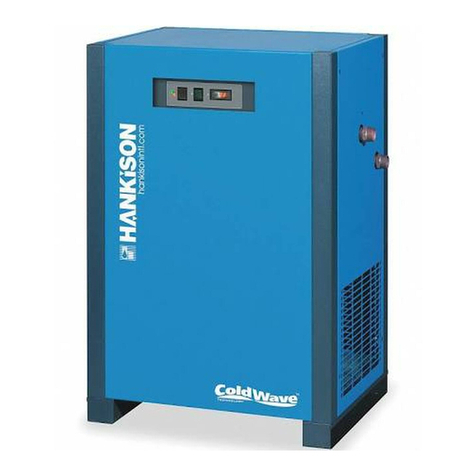
SPX
SPX Hankison HPRP Series User manual
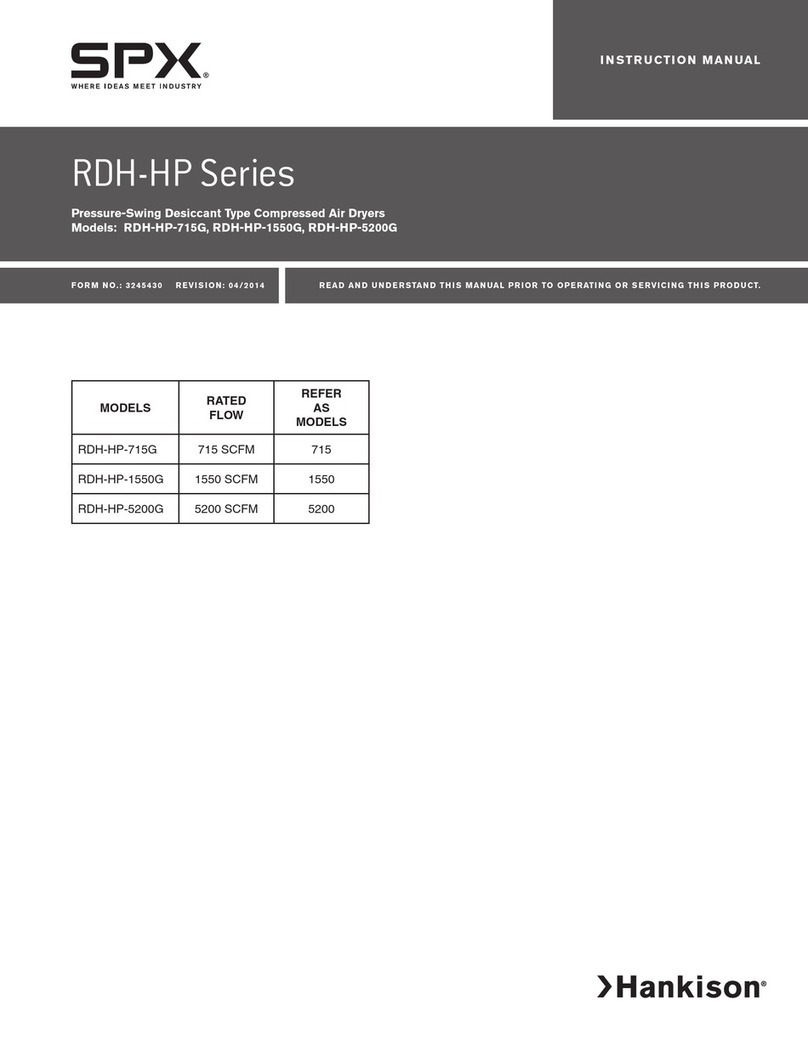
SPX
SPX RDH-HP Series User manual
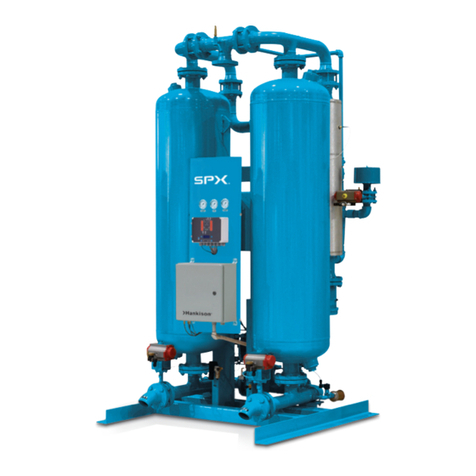
SPX
SPX HPD Series User manual

SPX
SPX HANKISON HES Series User manual
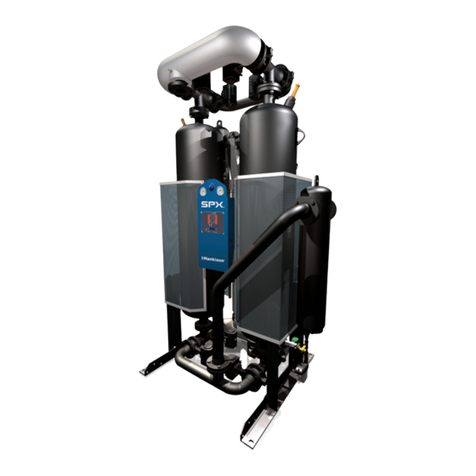
SPX
SPX HCD Series User manual
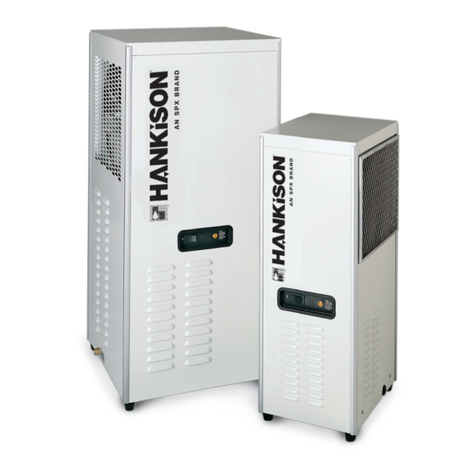
SPX
SPX HANKISON HIT Series User manual

SPX
SPX Hankison GCU Series User manual
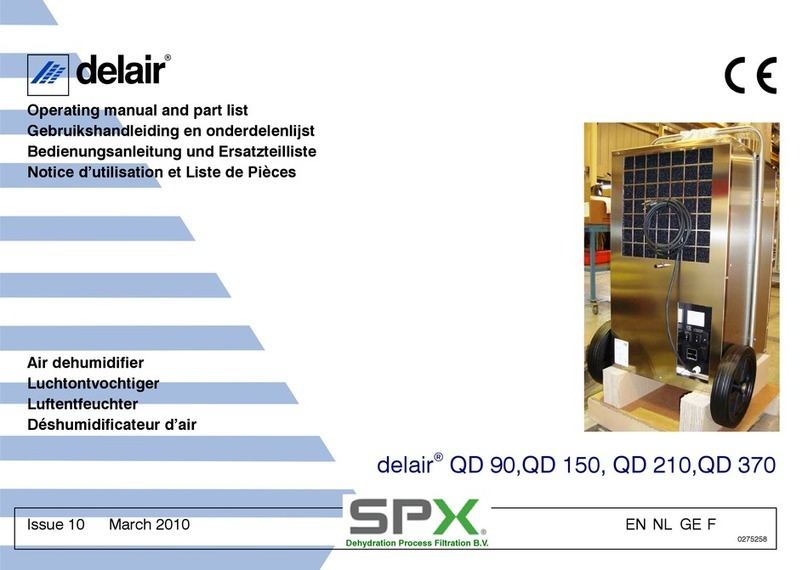
SPX
SPX DELAIR QD 90 User manual

SPX
SPX Pneumatic Products IBP500 User manual
